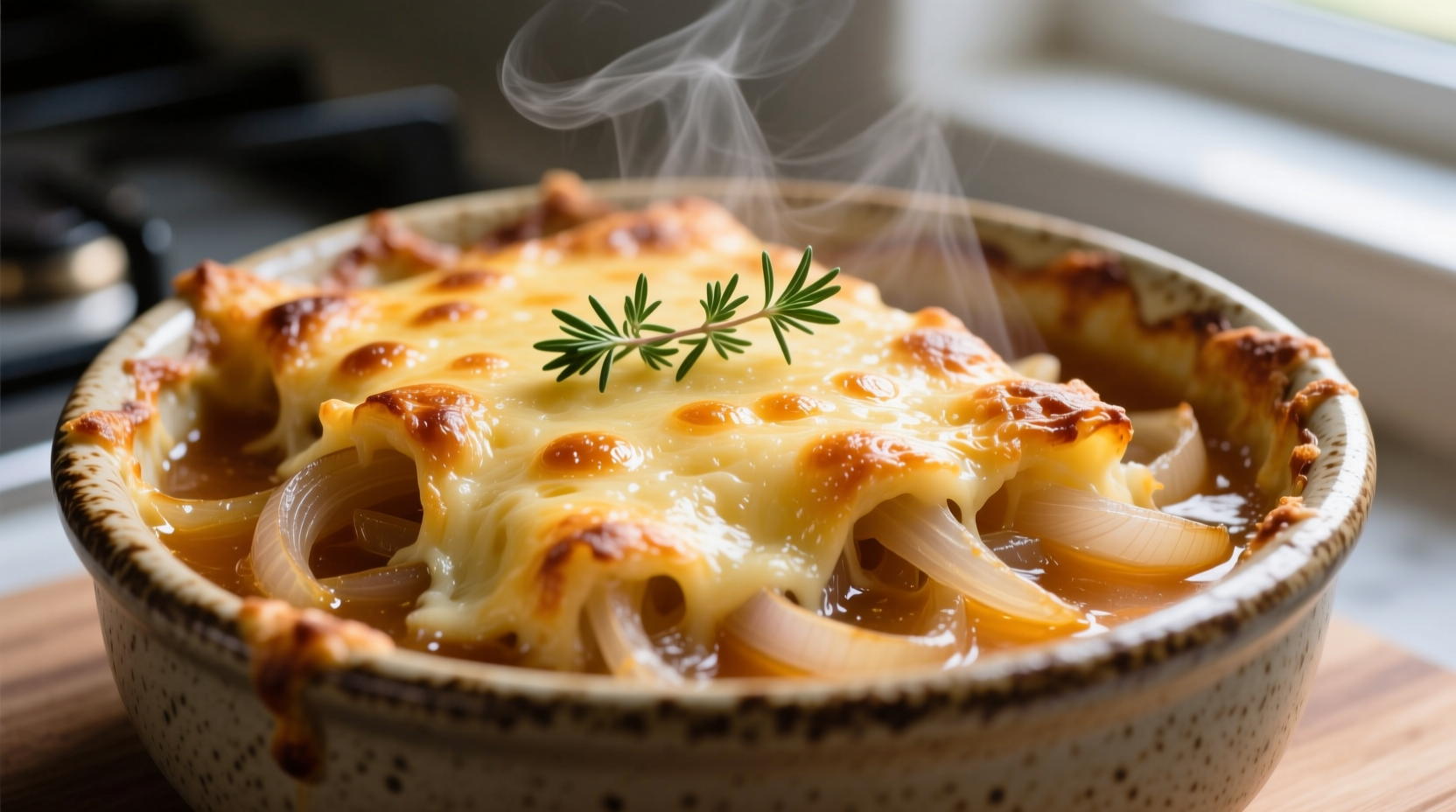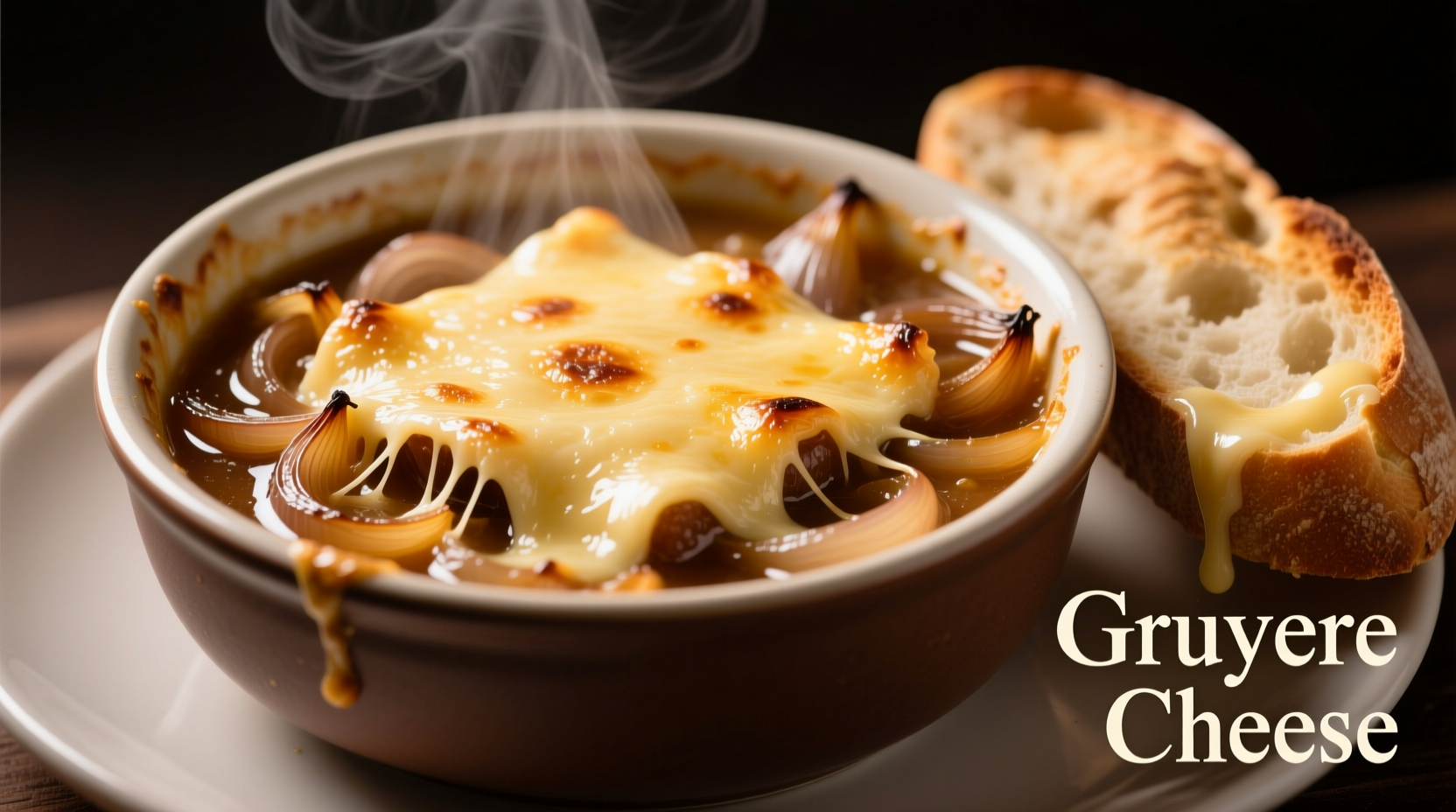When you're standing in your kitchen with caramelized onions ready to transform into that comforting bowl of French onion soup, choosing the right cheese isn't just important—it's essential to achieving that authentic Parisian bistro experience. Getting the cheese selection wrong can mean the difference between a rich, complex soup with that perfect melty crust and a disappointing bowl that lacks depth.
Why Gruyère Reigns Supreme in French Onion Soup
Gruyère has been the cheese of choice for traditional French onion soup since the dish gained popularity in 18th century Paris. This Swiss cheese, named after the town of Gruyères in Switzerland, brings several critical qualities to the dish:
- Superior melting properties—unlike many cheeses that become greasy or separate when heated, Gruyère maintains a smooth, velvety texture
- Complex flavor profile—its nutty, slightly sweet notes complement the caramelized onions without overpowering them
- Perfect browning capability—when broiled, it creates that iconic golden crust with just the right amount of crispiness
According to Larousse Gastronomique, the definitive French culinary encyclopedia, authentic French onion soup (soupe à l'oignon) specifically calls for Gruyère as the primary cheese. This recommendation has stood the test of time because Gruyère's flavor intensifies beautifully when melted, enhancing rather than dominating the soup's delicate onion broth base.
Cheese Comparison: What Works (and What Doesn't) for French Onion Soup
| Cheese Type | Melting Quality | Flavor Compatibility | Best Usage Recommendation |
|---|---|---|---|
| Gruyère (AOP) | Excellent | Ideal | Primary cheese for authentic results |
| Comté | Excellent | Excellent | Great alternative or blend with Gruyère |
| Emmental | Very Good | Good | Traditional in some French regions |
| Parmesan | Fair | Good (as accent) | Use in small amounts with Gruyère |
| Cheddar | Poor | Poor | Avoid—overpowers delicate flavors |
The Evolution of Cheese in French Onion Soup: A Brief Timeline
Understanding how cheese became integral to French onion soup requires looking at culinary history. While onions have been used in French cooking since medieval times, the modern version of French onion soup emerged in the 18th century:
- 1700s: French onion soup originated as a peasant dish, often made without cheese as dairy was expensive
- 1800s: As cheese production expanded, Gruyère began appearing in recipes from eastern France near the Swiss border
- Early 1900s: The dish gained international popularity, with American versions sometimes substituting more accessible cheeses
- Post-WWII: French culinary institutions like Le Cordon Bleu standardized Gruyère as the preferred cheese
The Institut National de l'Origine et de la Qualité (INAO), France's official organization for protecting food products with geographical indications, recognizes the importance of proper cheese selection in traditional French dishes. While French onion soup itself isn't protected by AOC (Appellation d'Origine Contrôlée), the cheeses used in authentic preparations often are.
Practical Considerations for Your Perfect French Onion Soup
When preparing French onion soup at home, understanding these practical limitations will help you achieve restaurant-quality results:
Cheese Freshness Matters Most
Freshly grated cheese always outperforms pre-shredded varieties. The anti-caking agents in pre-shredded cheese prevent proper melting and can create a grainy texture. For best results, use a box grater and grate your Gruyère just before adding it to the soup.
Regional Variations and Substitutions
While Gruyère is traditional, certain regional variations exist within France:
- In eastern France near the Swiss border, Emmental is sometimes used alone or blended with Gruyère
- In some Parisian bistros, a blend of Gruyère (70%) and Comté (30%) creates added complexity
- Outside France, where authentic Gruyère may be difficult to find, Comté makes the best substitute
The Science of Melting Cheese Properly
Food science explains why Gruyère works so well. According to research published in the Journal of Dairy Science, Gruyère has an ideal protein-to-fat ratio that allows it to melt smoothly without separating. The cheese's aging process (typically 5-12 months) develops enzymes that enhance its melting properties while creating those characteristic nutty flavors that complement caramelized onions perfectly.

Avoid These Common Cheese Mistakes
Even experienced home cooks make these cheese-related errors when preparing French onion soup:
- Using the wrong cheese temperature—cheese should be at room temperature before adding to hot soup
- Adding cheese to boiling soup—remove soup from heat before adding cheese to prevent clumping
- Using too much cheese—a thin, even layer creates the best crust without overwhelming the soup
- Broiling too long—3-5 minutes under the broiler is sufficient for perfect browning
Perfecting Your French Onion Soup Cheese Technique
For the most authentic French onion soup experience, follow these professional chef techniques:
- Use authentic AOP Gruyère when possible (look for the AOP designation on the label)
- Grate cheese finely using the small holes of a box grater for even melting
- Place soup croûtons directly on the soup surface before adding cheese
- Use a 70/30 blend of Gruyère and Comté for enhanced flavor complexity
- Broil until golden with small bubbles forming across the surface
Remember that the cheese isn't just a topping—it's an integral component that transforms the soup from a simple onion broth into a complete culinary experience. The perfect French onion soup cheese crust should be golden brown with delicate bubbles, slightly crisp on top but still molten underneath, creating that irresistible pull when you break through with your spoon.
Frequently Asked Questions
Can I use mozzarella instead of Gruyère for French onion soup?
Mozzarella isn't recommended as a primary cheese for French onion soup. While it melts well, its mild flavor doesn't complement the rich caramelized onions, and it lacks the nuttiness that defines authentic French onion soup. If you must substitute, use mozzarella only in combination with a stronger-flavored cheese like Parmesan (25% mozzarella, 75% Parmesan), but authentic results require Gruyère or Comté.
Why does my cheese crust become rubbery in French onion soup?
A rubbery cheese crust typically results from using pre-shredded cheese (which contains anti-caking agents that prevent proper melting) or from adding cheese to soup that's still boiling. Always use freshly grated cheese and add it to soup that's just below boiling point. The ideal technique is to ladle hot soup into oven-safe bowls, add toasted baguette slices, cover with freshly grated cheese, then broil until golden.
Is there a vegetarian alternative to traditional French onion soup cheese?
Yes, look for Gruyère or Comté made with microbial rennet (check labels for "vegetarian" or "microbial enzymes"). Many European producers offer vegetarian versions of these cheeses. Avoid American "French onion soup" cheeses which often contain animal rennet without clear labeling. For completely plant-based options, a blend of cashew cheese and nutritional yeast can work, though it won't replicate the authentic texture and flavor.
How much cheese should I use per serving of French onion soup?
The ideal amount is 1.5-2 ounces (40-55g) of freshly grated cheese per serving. This creates a substantial crust without overwhelming the soup. Professional chefs recommend measuring by weight rather than volume for consistency. Remember that the cheese should form a thin, even layer that completely covers the soup surface and croûton without piling up excessively.
Can I make French onion soup without cheese for dietary restrictions?
Traditional French onion soup requires cheese for its signature texture and flavor, but you can create a satisfying alternative. Try topping with toasted breadcrumbs mixed with nutritional yeast for umami flavor, or use a small amount of Parmesan-infused olive oil drizzled on top. While not authentic, these alternatives provide some complexity. For the closest experience without dairy, focus on perfecting your onion caramelization and broth depth to compensate for the missing cheese element.











 浙公网安备
33010002000092号
浙公网安备
33010002000092号 浙B2-20120091-4
浙B2-20120091-4